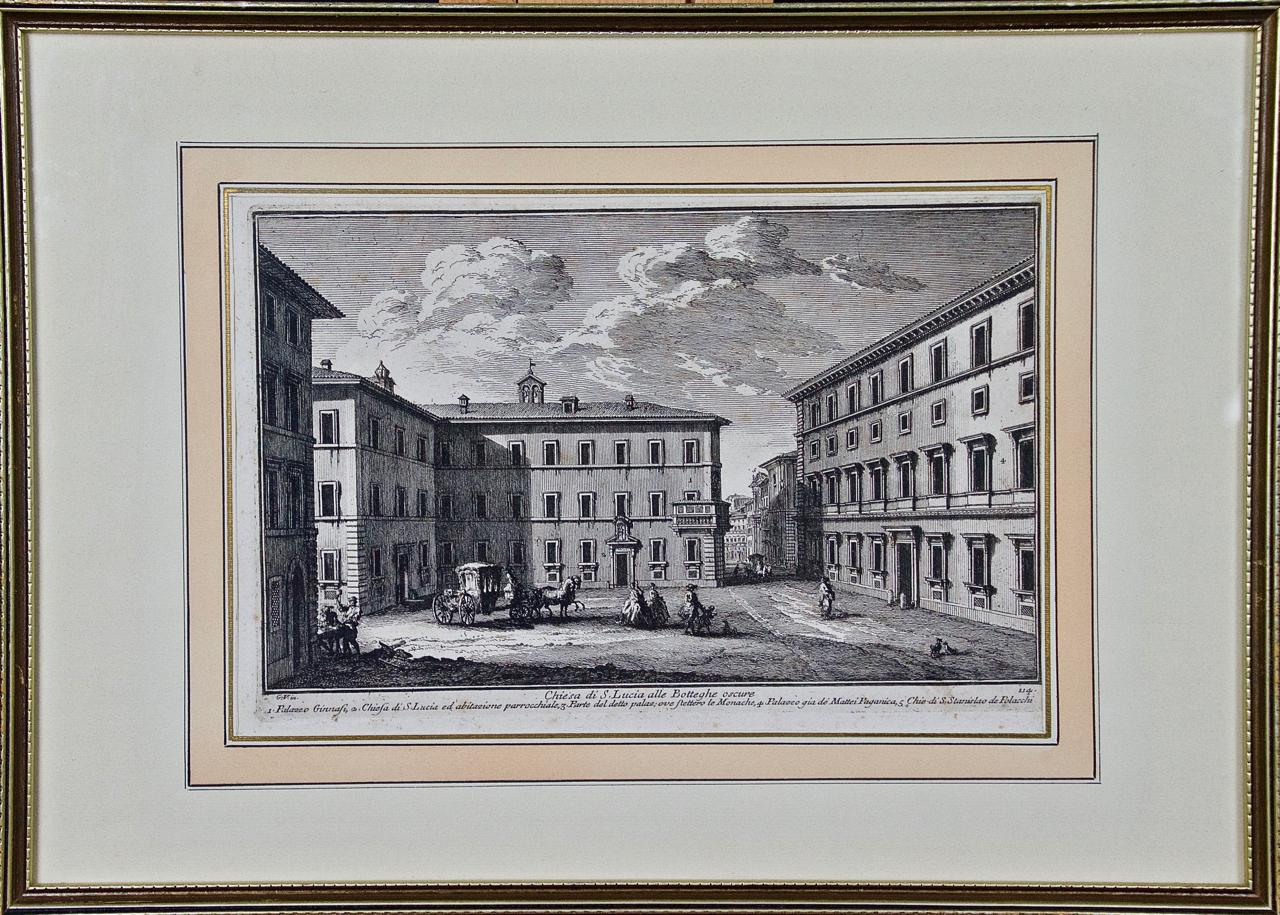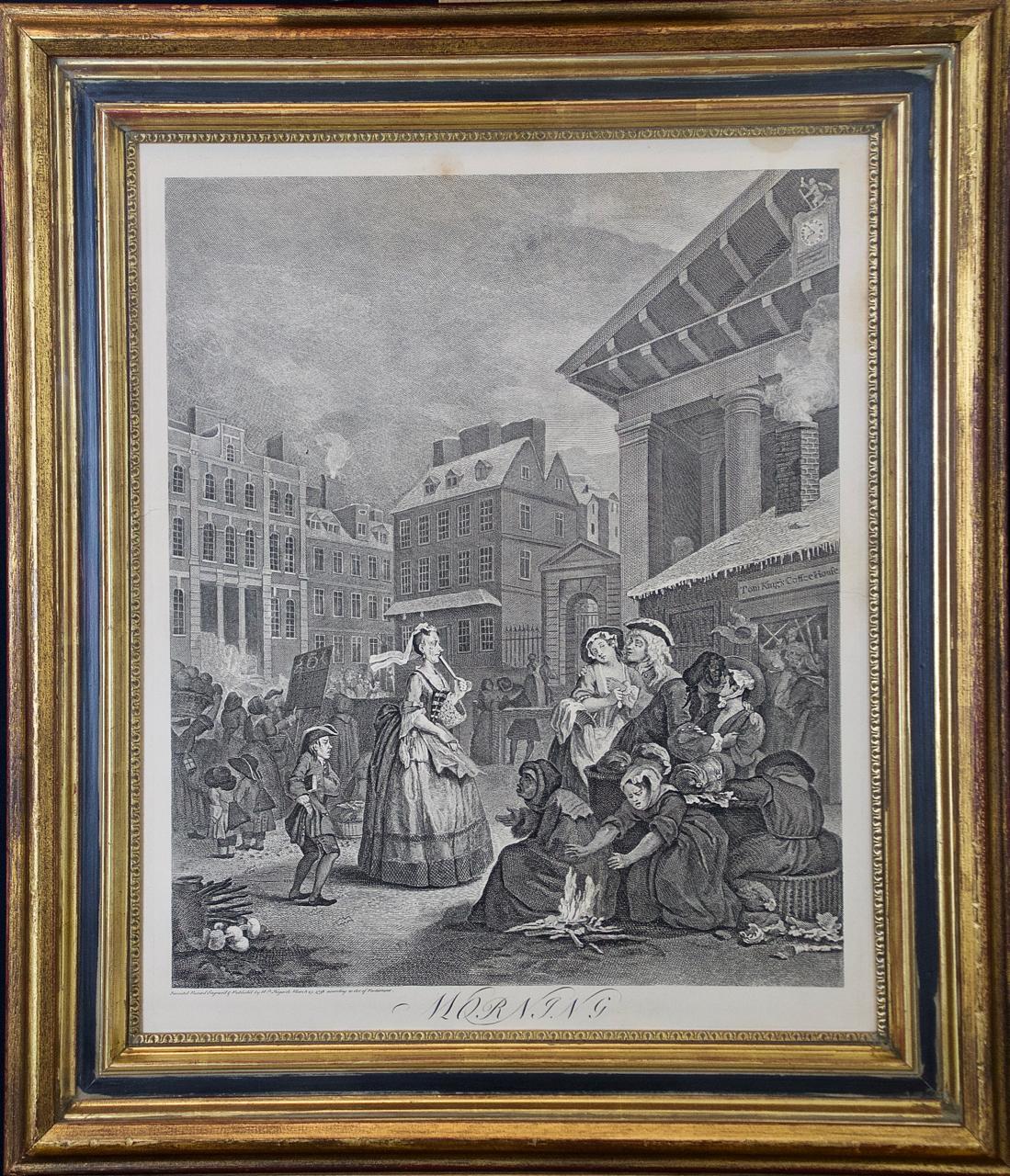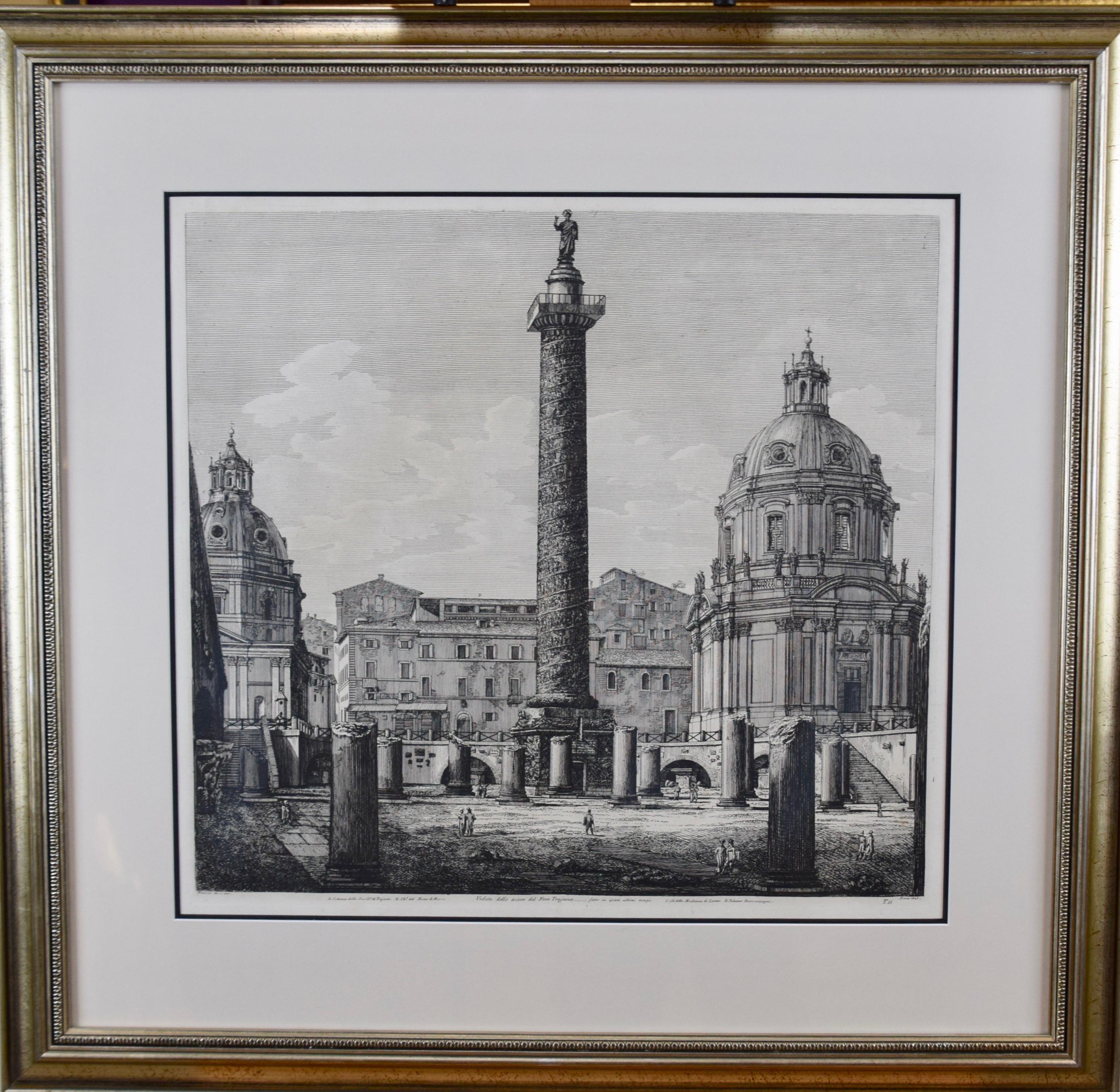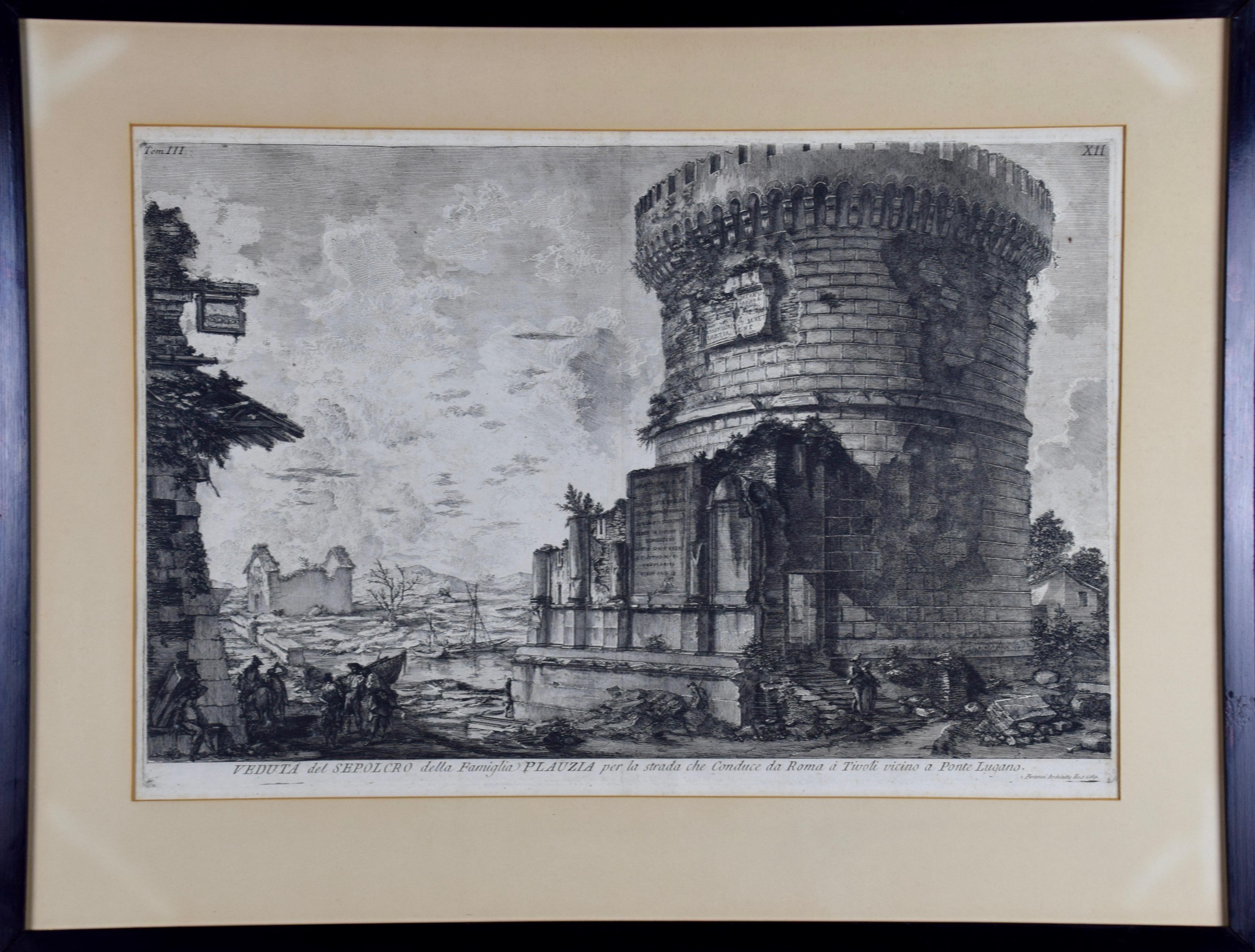Items Similar to "Figures at the Obelisk, " Original Etching Landscape by Jan Frans van Bloemen
Want more images or videos?
Request additional images or videos from the seller
1 of 8
Jan Frans van Bloemen (Orizzonte)"Figures at the Obelisk, " Original Etching Landscape by Jan Frans van Bloemen1670-1746
1670-1746
About the Item
"Figures at the Obelisk" is an original etching by Jan Frans van Bloemen. It depicts two people conversing in front of a monument. Behind them, an expansive landscape sprawls.
9 1/4" x 6 3/4" art
21 3/4" x 19 3/8" frame
Jan Frans van Bloemen (baptized 12 May 1662 - buried 13 June 1749) was a Flemish landscape painter mainly active in Rome. Here he was able to establish himself as the leading painter of views (vedute) of the Roman countryside depicted in the aesthetic of the classical landscape tradition.
Van Bloemen predominantly painted classical landscapes, taking his inspiration from the Roman Campagna. His landscapes, with their recession through a series of planes, soft, warm lightning and classical and religious subject matter, drew on the examples of artists such as Claude Lorrain and Gaspard Dughet. His paintings are exquisitely imbued with that "difficult-to-define pastoral ambience" which helped to make him such a great painter in the eyes of his contemporaries. The technique and subjects of the work of Jan Frans van Bloemen are also related to painters such as Jan Asselijn, Thomas Wyck, Willem Romeyn and Willem Schellinks. His painted vedute fall into the category of the vedute that combine reality with imaginary elements.
His landscapes have an Arcadian lushness, with mountains, streams, distant hamlets, and small inhabitants painted with imprecise pittura di tocco ('painting of touch') using small dotting and spirited brush-strokes. Unlike van Wittel, van Bloemen did not generally depict views of areas distant from Rome such as the Tiber valley or the Alban hills. His subjects were limited to views in the immediate vicinity of Rome, an outline of which was typically visible in his compositions. Van Bloemen was in particular known for his 'estate views' representing the estates of the nobility in the Roman Campagna. His views aim to associate the modern estate view with the classical arcadian landscape. Rather than offering the wide panoramic views, distant horizon and atmospheric effects associated with topographical landscapes, van Bloemen's estate views emphasize minute observation of reality and a limited viewpoint. The estates are thus made to appear as immutable features of the local landscape.
He worked together with other painters who painted the figures in his landscapes such as Carlo Maratti, Placido Costanzi and Pompeo Batoni. However, he only relied on such collaboration with figure painters in the last decades of his life when he produced his most ambitious classicising compositions. Even then he only relied on these figure specialists for the most prominent figures in the foreground while he took care of the minor characters. In fact, van Bloemen was an accomplished staffage painter and he was very skilled at quickly learning to imitate the style of his collaborators. As a result, many of the figures in his paintings that are attributed to prestigious contemporaries were actually by his own hand. He collaborated most frequently with Placido Costanzi. He regarded the pair of paintings representing The Flight to Egypt and The Rest on the Flight to Egypt as his best collaboration with Placido Costanzi who painted the figures.
His landscape drawings, which often depict imaginary ruins, have been confused with those of his brother Pieter, who is better known for his drawings of figures and animals. Jan Frans van Bloemen also made pen drawings of buildings in and around Rome.
- Creator:Jan Frans van Bloemen (Orizzonte) (1662-1749, Flemish)
- Creation Year:1670-1746
- Dimensions:Height: 21.75 in (55.25 cm)Width: 19.375 in (49.22 cm)
- Medium:
- Movement & Style:
- Period:
- Condition:
- Gallery Location:Milwaukee, WI
- Reference Number:
About the Seller
4.9
Platinum Seller
These expertly vetted sellers are 1stDibs' most experienced sellers and are rated highest by our customers.
Established in 1966
1stDibs seller since 2017
390 sales on 1stDibs
Typical response time: 1 hour
- ShippingRetrieving quote...Ships From: Milwaukee, WI
- Return PolicyA return for this item may be initiated within 14 days of delivery.
More From This SellerView All
- "Mythological Scene-Satyr & GoatHerder"an Original Etching signed by CastiglioneBy Giovanni Benedetto CastiglioneLocated in Milwaukee, WI"Mythological Scene--Satyr & Goat Herder" is an original etching signed by Italian artist Giovanni Benedetto Castiglione. It depicts a satyr lounging on the left and an approaching g...Category
Mid-17th Century Old Masters Landscape Prints
MaterialsEtching
- "Les Chevres (The Goats), " Etching Landscape by Claude Gelle Le LorrainBy Claude LorrainLocated in Milwaukee, WI"Les Chevres (The Goats)" is an original etching by Claude Lorrain. It depicts two pairs of goats and a shepherd watching over them. This etching is also in the collections of the Me...Category
1630s Old Masters Animal Prints
MaterialsEtching
- "Le Patre et la Bergere (The Herdsman & Shepherdess), " Etching by Claude GelleeBy Claude LorrainLocated in Milwaukee, WI"Le Patre et la Bergere (The Herdsman & Shepherdess)" is an etching by Claude Gellee (Le Lorrain). This etching is in the collections of the Metropolitan Museum and the British Museu...Category
Mid-17th Century Old Masters Landscape Prints
MaterialsEtching
- "Scene de Brigands, " Landscape Etching signed by Claude Gellee (Le Lorrain)By Claude LorrainLocated in Milwaukee, WI"Scene de Brigands" is an etching by Claude Gellee (Le Lorrain). This etching is in the collections of the Louvre and the Art Institute of Chicago. Publisher: Mannocci #11. 5" x 7...Category
Mid-17th Century Old Masters Landscape Prints
MaterialsEtching
- "Le Point de Bois (Rebecca & Eliezer), " etching by Claude Gellee (Le Lorrain)By Claude LorrainLocated in Milwaukee, WI"Le Point de Bois (Rebecca & Eliezer)" is an etching by Claude Gellee (Le Lorrain). This etching is in the collections of the Metropolitan Museum and the Louvre. Publisher: Mannocci ...Category
Mid-17th Century Old Masters Landscape Prints
MaterialsEtching
- "Le Bouvier (The Cowherd), " Landscape Etching by Claude Gelle Le LorrainBy Claude LorrainLocated in Milwaukee, WI"Le Bouvier (The Cowherd)" is an original etching by Claude Lorrain. It depicts a shepherd with a herd of cows. This etching is also in the collections of the Met and the Louvre. It ...Category
1630s Old Masters Landscape Prints
MaterialsEtching
You May Also Like
- 18th Century Etching of "Chiesa di S. Lucia" in Rome by Giuseppe VasiBy Giuseppe VasiLocated in Alamo, CAThis 18th century etching is entitled "Chiesa di S. Lucia alle Botteghe Oscure" by Giuseppe Vasi was published in Rome in 1747 in Vasi's 'Magnificenze di Roma Antica e Moderna', whic...Category
Mid-18th Century Old Masters Landscape Prints
MaterialsEtching
- Four Framed Hogarth Engravings "Four Times of the Day"By William HogarthLocated in Alamo, CAThe four plates in this "Four Times of the Day" set were created utilizing both engraving and etching techniques by William Hogarth in 1738. Hogarth's original copper plates were refurbished where needed by James Heath and these engravings were republished in London in 1822 by Braddock, Cradock & Joy. This was the last time Hogarth's original copper plates were used for printing. Most were melted down during World War I for the construction of bombs. Printed upon early nineteenth century wove paper and with large, full margins as published by William Heath in 1822. The inscription below each print reads "Invented Painted & Engraved by Wm. Hogarth & Publish'd March 25. 1738 according to Act of Parliament". These large folio sized "Four Times of the Day" engravings/etchings are presented in complex gold-colored wood frames with black bands and scalloped gold inner trim. A majority of each thick impressive frame is covered with glass applied near the outer edge. Each frame measures 25.75" high, 22.25" wide and 1.88" deep. There are a few small dents in the edge of these frames, which are otherwise in very good condition. "Morning" has two focal areas of discoloration in the upper margin and some discoloration in the right margin, a short tear in the left margin and a short tear or crease in the right margin. "Noon" has a spot in the upper margin that extends into the upper image, but it is otherwise in very good condition. "Evening" has a faint spot in the upper margin, but it is otherwise in very good condition. "Night" is in excellent condition. The "Four Times of the Day" series is in the collection of many major museums, including: The British Museum, The Metropolitan Museum of Art, The Tate Museum, The Chicago Art Institute and The Victoria and Albert Museum. Through this series Hogarth is portraying early 18th century London street life at "Four Times of the Day". His characters are exhibiting their personalities, quircks, strange activities, but he also wants to draw attention the disparities between the wealthy aristocracy and the common working class. Plate 1, "Morning" depicts morning in Covent Garden in the winter in front of Tom King...Category
Mid-18th Century Old Masters Landscape Prints
MaterialsEngraving, Etching
- The Column of Trajan in Rome, 19th Century Framed Etching by Luigi RossiniBy Luigi RossiniLocated in Alamo, CAEarly 19th century etching entitled "Veduta dello scavo del Foro Trajano" from Luigi Rossini's "Le Antichita Romane" (Ancient Rome), published in Rome in 1823. It depicts the historical victory column of Trajan standing amidst broken ancient Roman columns that lie around it. The column in Trajan's Forum commemorates Roman emperor Trajan's victory in the Dacian Wars. Buildings in the background represent two libraries and the Basilica Ulpia. There are people in the foreground; some walking through the square, some standing observing the scene and others in discussion. The etching is presented in a silver-colored wood frame with an off-white double mat with a black inner mat. It is in very good condition. See item # LU117324669702 for another Rossini etching...Category
1820s Old Masters Figurative Prints
MaterialsEtching
- The Basilica of St. Paul in Rome, Early 19th Century Etching by Luigi RossiniBy Luigi RossiniLocated in Alamo, CA"Rovina della gran Basilica di S. Paolo fueri le mura accaduta" (View of the Ruins of the Great Triumphal Arch of S. Paolo Fuori le Mura) from "Le Antichita Romane" (Ancient Rome), published in Rome in 1823. It depicts the destruction of the Basilica of St. Paul after the fire of 1823. People stand in the road and on the right observing the damage amid debris, which includes many fragments of columns. The etching is presented in a silver-color wood frame with an off-white double mat with a black inner mat. There are a few small spots, but it is otherwise in very good condition. See item # LU117324669722 for another Rossini etching...Category
1820s Old Masters Figurative Prints
MaterialsEtching
- Giovanni Piranesi Etching of Ancient Roman Architecture, 18th CenturyBy Giovanni Battista PiranesiLocated in Alamo, CA"Veduta del Sepolcro della Famiglia Plauzia per la Strada Che Conduce da Roma a Tivoli vicino a Ponte Lugano" from "Le Antichità Romane" (Roman Antiquities), one of the most famous works by Piranesi. "Antichita" illustrates the tombs along the Appian Way...Category
Early 18th Century Old Masters Figurative Prints
MaterialsEtching, Engraving, Drypoint
- Piranesi Etching of Ancient Roman Architectural Objects, "A sua Eccellenza"By Giovanni Battista PiranesiLocated in Alamo, CA"A sua Eccellenza il Signor Henry Hope Cav. Scozzese Amatore delle Belle Arti from "Vasi, Candelabri, Cippi, Sarcofagi, Tripodi, Lucerne, Ed Ornamenti Antichi", (Vases, candelabra, grave stones, sarcophagi, tripods, lamps, and ancient ornaments) is an etching by Giovanni Battista Piranesi, published in 1778. It depicts stone caryatids...Category
1770s Old Masters Figurative Prints
MaterialsEtching
Recently Viewed
View AllMore Ways To Browse
Flights To Antique
Pair Old Masters
Pair Of Old Masters
Etchings Pair
Pair Of Etchings
Old Masters Religious
Thomas Hand Landscape Painting
Old Master Religious Art
The Rest On The Flight
Pair 4 Prints
Old Master Etching Frame
18th Century Pen
Pair 18th Century Prints
18th Century Etchings Framed
6 18th Century Print
Plane Etching
18th Ruins Painting
Campagna Used





